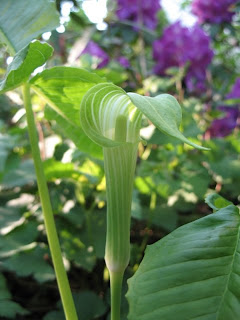Recent Acquisitions


Here are our purchases from a recent Master Gardeners sale. Several Polygonatum, Solomon's Seal, a Trillium and a Hepatica. Thankfully the plants we separated by botanical names so I headed straight for the P's for Polygonatum to beat the large crowd because I wanted to add a few more to the woodland garden. The Trillium and Hepatica were under a tent named collector's corner where they had unusual, commercially obtained plants. I told my wife to scout that area to find anything unusual that caught her eye and she was able to get the Trillium, Hepatica and tiny Polygonatum before they were all gone. She has a good eye for plants.

This is the Polygonatum humile a tiny Solomon's Seal. Humile for humility? We bought two of these plants - they were too cute.

This is Polygonatum odoratum, variegatum. The MasterGardener who checked us out said she donated these plants. I asked if they had a scent because of the name but she replied that it didn't or only a faint scent she could barely detect.

Polygonatum odoratum. Just the plain one, not variegated like the one above. These have not done well. They barely grew, the buds didn't open any more than in the photo and the two plants we bought have already wilted while the other Polygonatums are still flowering and doing well. I could detect no scent.


Two close ups of Polygonatum biflora which is something of a misnomer because there are as many flowers that are triplets as doubles. The first picture a bud closeup of the variegated leaf variety and the following one of the open flowers on the plain leafed one.

And...Trillium luteum "Lemon Yellow". I was hoping the growth on top of the leaves were flower buds but they turned out to be just appendages of the leaves. Rats, I thought I'd get to see it bloom in the first year. Not so!
No close up of the Hepatica but it's in the box in the first photo. Hepatica nobilis var. obtusa (H. americana) - Round-lobed Hepatica a relative of the anemones. The tag reads blue- violet flowers. I hope so because I have the white flowered one which is quite humble and could use the 'Humile' appellation.
The cost for all these plants? $45.00 We almost turned back to buy more when we realized how cheap they were. The most expensive ones were under the tent. 9 plants, two in gallon pots for $45.00. Five bucks apiece. What a bargain.


















































